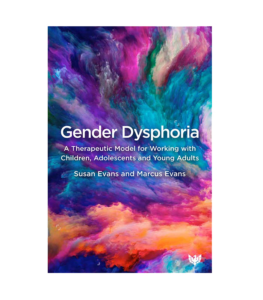
Susan Evans is a psychoanalytic psychotherapist. She worked for nearly 40 years in a variety of mental health services in the NHS, including the national gender identity service for children. She now has a private practice in South East London. She is a member of the British Psychotherapy Foundation, the London Psychoanalytic Psychotherapy Service, and is registered with the British Psychoanalytic Council.

Marcus Evans is a psychoanalyst with the British Psychoanalytical Society. He worked in mental health services and as an adult psychotherapist in the NHS for 40 years. For several years he was Clinical Lead of the Adult and Adolescent Departments at the Tavistock & Portman NHSFT. He is the author of Making Room for Madness in Mental Health and Psychoanalytic Thinking in Mental Health Settings
Here they give a brief overview of the complexities of working with gender dysphoria, something which is explored in greater detail in their new book, Gender Dysphoria: A Therapeutic Model for Working with Children, Adolescents and Young Adults
One of the most challenging tasks for all of us is to grow up and come to terms with who we are and how we fit in. To achieve this, as children, we need to have a sense of curiosity and a wish to explore ourselves in relation to others and the outside world, with encouragement and support from the adults around us. This helps us to develop a sense of self and the skills needed to master the various tasks and events in our lives and relationships. However, this exploration in the journey towards adulthood exposes the more painful realities of life, and each new challenge has to be psychologically as well as physically negotiated and integrated. For some of us, the early idealistic expectation of a pleasure-driven, pain-free life can be extremely difficult to relinquish. We all utilise psychic defences to protect our minds from the frequent conflicts and pain of life, but some may feel more vulnerable or fragile and thus rely on primitive psychic defences, which can be firmly embedded in the personality. In this mental state the child tends to avoid the psychological struggles which require some flexibility, and instead retreat into a more fixed state of mind which insulate him/her from the emotional challenges of development. Curiosity about the internal world may be felt to threaten these rigid belief systems, and this leads to a sense that one cannot think about the mind at all.
Part of any good psychotherapeutic work is to help an individual feel listened to and to develop an alliance between patient and therapist which is sufficiently empathetic and humane. Our experience of working with young people who have gender dysphoria shows that if we sensitively explore their mind and feelings in more depth, they often express self-loathing and a sense of being lost and disappointed.
There has been an exponential rise in the numbers of children presenting with gender identity issues in the last decade. While there are commonalities and shared aspects in the presentation of gender dysphoria, it is important to note that each and every child who experiences symptoms is unique, and the individual’s personality and choices are driven by many interlocking factors, including genetic inheritance, environmental factors, family dynamics, and peer and social influences.
Unfortunately, the current tendency is to push any gender identity issues towards ‘specialist’ treatment and so patients are swiftly referred to gender clinics, often with long waiting lists. These services mostly operate under an ‘affirmative model’ and a more in-depth psychological assessment is often omitted. Instead, patients are directed towards medical transition, which has life-changing implications and complications. We advocate for exploratory and supportive psychological work during this developmental period instead. Whether or not the person decides to go on to transition, this work is good preparation for their future life.
Chidren, adolescents and young people change as they mature. Therefore, we hold that it is imperative to keep the developmental path open into adulthood. No long-term social or medical decisions should be made on the basis of a snapshot psychiatric diagnosis in childhood, even if the presentation appears consistent and persistent.
This is a complicated clinical area. There are many confusions and clinical presentations that are not yet fully understood. As always in clinical work, some of the best thinking is done in hindsight. In many ways, our book is a study of the ways that all of us, as individuals, try to minimise and avoid psychic pain. Inevitably, due to the conflicts and levels of distress that lie behind the gender dysphoric presentation, all parties involved in this work will be subject to forceful emotional states and reactions which can intermittently push thinking and empathy out of the therapeutic encounter. Occasionally, therapists, patients, and their families may find themselves locked in an impasse in the therapeutic relationship. At times such as these, there is a tendency towards action rather than thought. However, these negative therapeutic reactions need to be weathered. They often offer an opportunity to deepen the understanding of the forces operating within the psychodynamic relationships. Any psychological assessment, exploration, or therapy should always be undertaken with an open state of mind.
The area of gender care is a poorly researched one, but the most robust evidence that does exist at the time of writing, states that if young patients are given psychological support, then well over three quarters who experience gender dysphoria and a wish to transition will desist or learn to live with and manage their symptoms and feelings.
At the moment, this is a clinical area where exploration and curiosity have been somewhat sidelined. At heart, our hope is that Gender Dysphoria: A Therapeutic Model for Working with Children, Adolescents and Young Adults will encourage more professionals to engage with work in this area and believe that there is much we can learn from our patients about this subject.
Susan Evans and Marcus Evans

